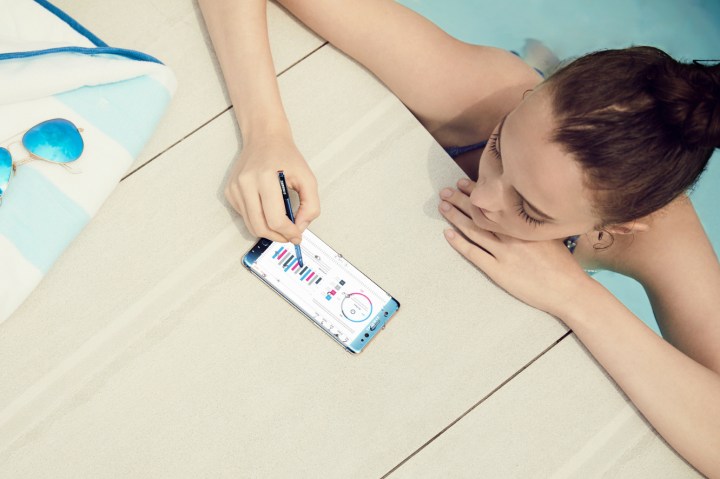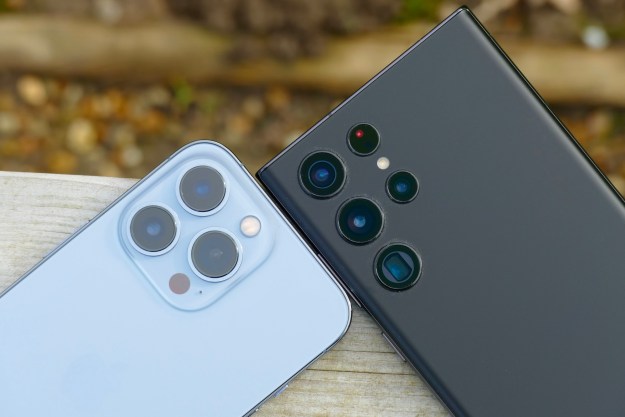
“For the benefit of consumers’ safety, we stopped sales and exchanges of the Galaxy Note 7 and have consequently decided to stop production,” Samsung told Digital Trends in a statement.
If you have a Galaxy Note 7, please return it immediately to the place where you purchased it. You are entitled to a full refund or an exchange for a replacement device of equal value, as per the Consumer Product Safety Commission’s recall. Please see our full guide on how to return your Note 7 here. The guide also includes recommendations of which device to buy instead.
Samsung’s Galaxy Note 7 is here and it’s packed with top-of-the-line specs we’ve seen in many other flagships this year. While it shares a lot of internals and design cues, such as the dual-edge display, with the Galaxy S7 Edge, the Note 7 stands out by being Samsung’s first flagship smartphone with a USB Type-C charging port and an iris scanner.
Below continues our original spec comparison of the
Specs and design
Specs
iPhone 6S Plus |
Galaxy Note 7 |
|
| Size | 158.2 x 77.9 x 7.3mm (6.23 x 3.07 x 0.29 in) | 153.5 x 73.9 x 7.9 mm (6.04 x 2.91 x 0.31 in) |
| Weight | 6.77 ounces (192g) | 5.96 ounces (169g) |
| Screen | 5.5-inch IPS LCD | Dual-edge, 5.7-inch Quad HD Super AMOLED |
| Resolution | 1,920 x 1,080 pixels | 2,560 × 1,440 pixels |
| OS | iOS 9, upgradeable to iOS 9.3.3 | Android 6.0.1 Marshmallow |
| Storage | 16GB, 64GB, 128GB | 64GB |
| MicroSD card slot | No | Yes, up to 256GB |
| NFC support | Yes (Apple Pay Only) | Yes |
| Processor | 64-bit Apple A9 processor | Qualcomm MSM8996, Snapdragon 820 (U.S. Models), Exynos 8890 Octa (International Models) |
| 2GB | 4GB | |
| Connectivity | Wi-Fi, GSM, CDMA, HSPA, EVDO, LTE-A | Wi-Fi, GSM, 4G LTE, HSPA |
| Camera | Front 5MP, Rear 12MP | Front 5MP, Rear 12MP |
| Video | 2160p |
2,160p |
| Bluetooth | Yes, version 4.2 | Yes, version 4.2 |
| Fingerprint sensor | Yes | Yes |
| Iris scanner | No | Yes |
| Misc. | 3D Touch | S Pen |
| Water resistant | No | Yes |
| Battery | Non-removable Li-Po 2,915 mAh battery | Non-removable Li-Po 3,500mAh battery |
| Charger | Lightning | USB Type-C |
| Quick charging | No | Yes |
| Wireless charging | No | Yes, Qi and PMA |
| Marketplace | Apple App Store | Google Play Store |
| Color offerings | Gold, silver, gray, and rose gold | Black, white, gold, silver |
| Availability | AT&T, Verizon, Sprint, T-Mobile | AT&T, Verizon, Sprint, T-Mobile |
| DT review | 4.5 out of 5 stars | Pending |
It’s hard to compare the specifications of an
In terms of storage, Apple starts out with 16GB — which is abysmal in this day and age — but it progresses with a 64GB and 128GB version. There is no MicroSD card slot, so unless you get a case that can add extra storage, you’re stuck with whichever variant you choose.
Apple’s
You can also get 256GB MicroSD cards starting from $80 on Amazon, so even without the deal it’s still cheaper to go that route instead of opting for the 128GB variant of the
Spec-wise, Samsung also beats the iPhone out with 4GB of
The Note 7 comes with the S Pen stylus, but the
Winner: Samsung Galaxy Note 7
Design and durability
Design is purely subjective — Samsung has come to form its own design language, and Apple’s famous iPhone design scheme has continued to improve since the first iPhone. There are some notable differences to consider, however. The Galaxy Note 7 has a glass back and front — that means it’s prone to fingerprints and may be harder and costlier to replace if the glass breaks. On the plus side, Samsung is using the all new Gorilla Glass 5 on both sides, which means the glass is tougher than ever.
The Note 7 also has an IP68 rating, meaning that you can dunk it in 1 meter of water for up to 30 minutes. The S Pen also has the same rating, in case you wanted to jot some notes down while in the pool.
There’s also the dual-edge display on the Galaxy Note 7 to consider — if you like the look of the Galaxy S7 Edge, know that Samsung has improved on it to make the Note 7 comfier to hold. And while there are a few new Edge Panel features, the dual-edge display wins points for its design aesthetic — it makes the Note 7 look drop-dead gorgeous.
The
One last factor that may swing your vote is that while the Galaxy Note 7 has a slightly larger display at 5.7-inches, compared to the
Between phablets, it seems like the Note 7 has a little more to offer for its size and features. But of course, design is only one part of the equation — the iPhone is likely easier to repair and won’t be covered with smudges.
Winner: Tie
Display, camera, software, and pricing
Display
The
So with the slightly larger screen, you’re getting a higher resolution. You’re also getting a higher pixel density with 518 pixels per inch. The iPhone packs 401 pixels per inch.
The Note 7 also uses Samsung’s Super AMOLED display, which offers deeper blacks and brighter colors — though they can be a little over-saturated at times. The iPhone uses older technology, IPS LCD, but that doesn’t means its displays suffer. You’ll still find sharp details and good color.
The iPhone also has a pressure-sensitive screen, which is required for 3D Touch. 3D Touch is kind of like right-clicking a mouse on desktops — you get more options and shortcuts to actions for apps. It’s a brilliantly-useful feature, but Samsung’s not without its own tricks.
The Edge Panel lets you add shortcuts to all sorts of apps and content, and it makes the
Winner: Samsung Galaxy Note 7
Camera
Cameras have always been one of the hallmarks of the iPhone, but Samsung has taken the crown on multiple occasions in recent years. The Korean company has done it again — the Note 7 maintains the same dual-pixel cameras that power the Galaxy S7 Edge.
You’ll find that both devices have the same megapixel count — the rear camera packs a 12-megapixel camera, and the front camera for both has 5 megapixels. But the pixels in the Note 7 camera sensor are larger, providing faster autofocus and improved shots in low-light situations. Samsung also has an aperture of f/1.7 lens for both cameras — that means images can get brighter and offers more depth of field.
That hardly means the iPhone’s camera is subpar; in fact, it holds up incredibly well. But compared to the Note 7, it does have an f/2.2 lens, which means it won’t have as good bokeh as its Korean counterpart.
Winner: Samsung Galaxy Note 7
Software and usability
This category is similar to design, in that it’s subjective. Most people have already decided their camps — whether it’s iOS,

It’s not that the Note 7 or
You’ll never be let down by a lack of apps on either platform. Both app stores on the operating systems are thriving, and while many apps tend to release on iOS first, an
Note 7-wise, there are some features that stand out from other
Still, iOS 9.3.3 has a large list of features that would take a while to go through, and even then it still comes down to personal preference.
iOS does get more updates for security and new features, which gives it the edge here.
Winner:
Pricing and availability
Both of these devices are among the most expensive mainstream smartphones available. The Galaxy Note 7 started at $850 for the only 64GB variant, and the
They’re mostly equally matched in price when you choose the iPhone variant with the same internal storage, but remember — the Note 7 comes with a MicroSD card that lets you add up to 256GB. And Samsung has a limited-time deal that offers up the Gear Fit 2 or a 256GB MicroSD card for free when you purchase a Galaxy Note 7.
Of course, the Galaxy Note 7 is no longer available from any carrier — so you’ll only be able to get the
- AT&T: The iPhone 6S Plus 64GB costs $750 at full price, or $25.00 per month for 30 months.
- T-Mobile: The iPhone 6S Plus 64GB costs $650 at full price, or $26.00 per month for 24 months.
- Verizon: The iPhone 6S Plus 64GB costs $650 at full price, or $27.08 per month for 24 months.
- Sprint: The iPhone 6S Plus 64GB costs $650 at full price, or $14.59 per month for 24 months with a $100 down payment.
Winner:
Galaxy Note 7 wins
The Galaxy Note 7 beats the
Key updated features over the previous Note 5 are the iris scanner, the USB Type-C port, and the dual-edge display. The
Choosing between an iPhone and an
Of course, there’s another thing to consider — you don’t really have a choice in which phone to buy. Between these two phones, you can only get the
Editors' Recommendations
- Best refurbished iPhone deals: Get an iPhone 14 for $513
- Best iPhone deals: Save on iPhone 15, iPhone 15 Pro Max and more
- iPhone 16: news, rumored price, release date, and more
- 10 iPhone productivity apps you need to download right now
- Best iPhone 15 deals: How to get Apple’s latest iPhone for free







